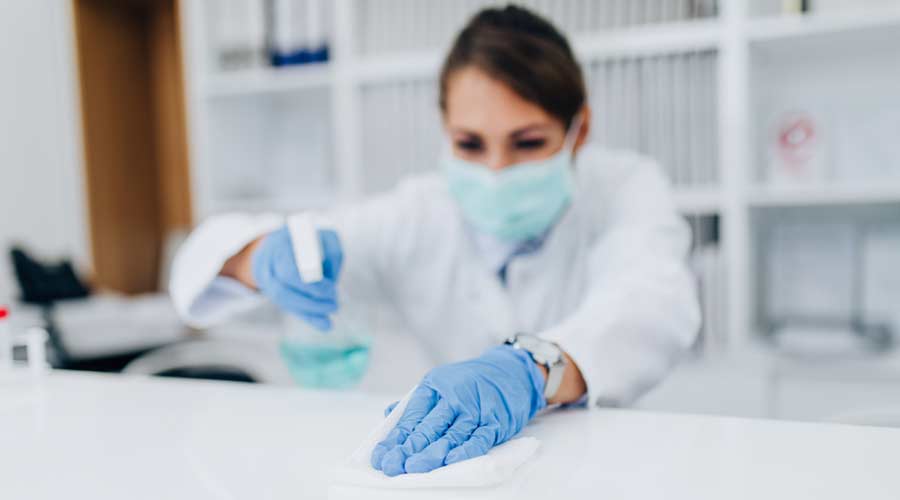The word "fit" has several meanings. The one that applies here is, “of a good enough standard for someone or something.” The relevant sense of the noun purpose is, “the aim that … something is intended to achieve.” Something that’s fit for purpose is, plainly put, good enough to do the job it was designed to do.
If hygiene procedures are to be effective, a determination needs to be made regarding not only product efficacy but more importantly, whether the process results in what we want to achieve — namely, hands and environmental surfaces, which are hygienically clean, and fit for purpose, as sufficient to break the chain of infection transmission.
The concept of fit for purpose disinfection argues that effective and thorough cleaning with high-quality detergents across all non-critical touch surfaces is as effective, if not more so, than widespread use of disinfectants. By removing soil and sources of food for pathogens from a surface through rigorous cleaning, the microbial load on any surface can be brought to levels that are not considered harmful.
Are healthcare-associated infections (HAI) and the substantial economic burden they cause inevitable? Far from it. Many such infections are preventable through better hand hygiene and proper disinfection of high-touch surfaces alone. While poor compliance with hand hygiene remains a perennial problem, my focus here is on problems with disinfection of frequently touched, hard, nonporous environmental surfaces.
Cleaning is the process of removing contaminants from the environment and putting them in their place. Cleaning occurs after contaminants have entered the indoor environment. In cleaning, we find, identify, capture, contain, remove and dispose of contaminants. Cleaning is not diluting. Cleaning is removing.
We don’t hide or brush aside dust and waste and say we’re cleaning. We must remove and dispose of them, too. The U.S. Center for Disease Control and Prevention (CDC) definition for cleaning refers to the removal of dirt and impurities, including germs, from surfaces. Cleaning alone does not kill germs. But by removing the germs, it decreases their number and, therefore, any risk of spreading infection.
The CDC’s definition for disinfecting works by using chemicals to kill germs on surfaces. This process does not necessarily clean dirty surfaces or remove germs. But killing germs remaining on a surface after cleaning further reduces the risk of spreading infection.
For an environment to be considered disinfected, we remove or make the vast majority (95 percent) of harmful substances in it. We eliminate the pathogens that are most threatening to humans. A disinfected condition can be achieved, but only with much work.
For an environment to be considered sanitary, we clean it to the point that it protects human health in general, but it still has some contamination. A risk of disease still exists, but it is at an acceptable risk level or fit for purpose. At a minimum, cleaning must always achieve a state of sanitation. An unsanitary condition poses a likely health risk. The purpose of cleaning is to correct the risky condition. Therefore, if a risk has not been improved to a level we call sanitary, fit for purpose disinfection has not been accomplished.
Who knows how many lives can be saved through consistent and effectual cleaning and disinfection? It's the accident that never happened.
J. Darrel Hicks, BA, MESRE, CHESP, Certificate of Mastery in Infection Prevention is the Past President of the Healthcare Surfaces Institute. Hicks is nationally recognized as a subject matter expert in infection prevention and control as it relates to cleaning. He is the owner/principal of Safe, Clean and Disinfected. His enterprise specializes in B2B consulting, webinar presentations, seminars and facility consulting services related to cleaning and disinfection. Learn more at www.darrelhicks.com.

 Designing Healthcare Facilities for Pediatric and Geriatric Populations
Designing Healthcare Facilities for Pediatric and Geriatric Populations Kaiser Permanente Announces New Hospital Tower at Sunnyside Medical Center
Kaiser Permanente Announces New Hospital Tower at Sunnyside Medical Center Building Disaster Resilience Through Collaboration
Building Disaster Resilience Through Collaboration Amae Health Expands to New York City
Amae Health Expands to New York City Hospital for Special Surgery Opens Two New Facilities in New Jersey
Hospital for Special Surgery Opens Two New Facilities in New Jersey